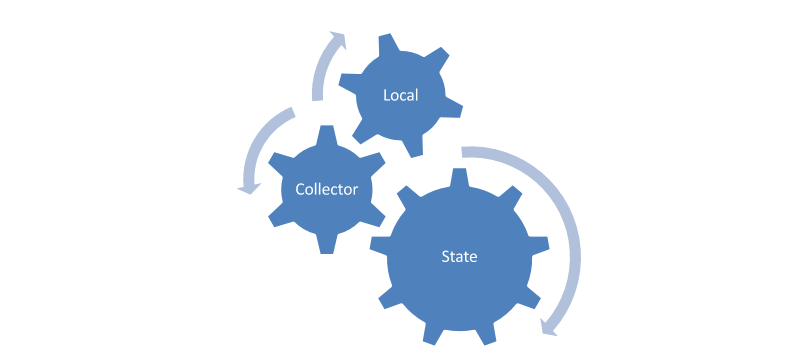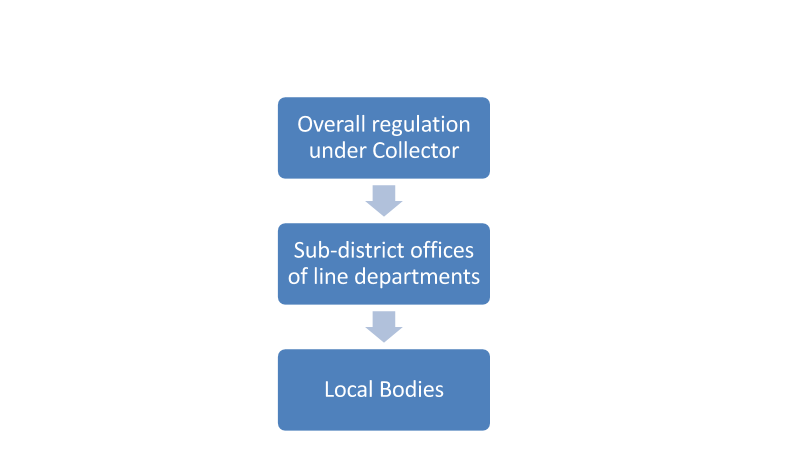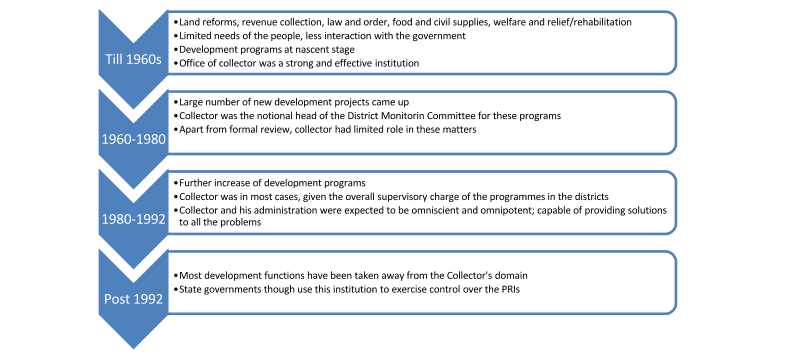<–2/”>a >District has been the basic unit of administration in India since ancient times. In India, we have a democratic welfare state which involves wide scope of activities for the development of the people and the nation as a whole. District Administration, is that part of Public Administration which functions in the territorial limits of the district.
District has been the basic unit of administration in India since ancient times. In India, we have a democratic welfare state which involves wide scope of activities for the development of the people and the nation as a whole. District administration, is that part of public administration which functions in the territorial limits of the district.
There exists an organic link between the collector and the State Government as well as the collector and the local administration. There three are like gears that enable proper administration. They have to work in coordination.
What should be the governing principle of this state-collector-local relationship?
• Principles of subsidiarity and decentralisation should govern their relationship
Structure of district administration
Evolution of collector post independence Or Changing role of district collector
• Agents of change, of Good Governance and Development Administration.
• The collectors have a first hand experience in dealing with the hopes and aspirations, the lives and livelihoods of the people. The state and central governments benefit immensely from this experience
• After 73rd and 74th amendments
o Role of the collector has been transformed into that of a coordinator, facilitator and a person who is responsible for inter-sectoral coordination of various activities that characterise the work of our grassroot administration
Significance of district admin (significance of collector)
• As the role of the government gets redefined and its becoming more and more citizen centric, the cutting edge of a government’s function is at the district and lower levels
• India lives in its districts. District is the basic unit of administration.
• Provision of Education and Health facilities, Infrastructure-2/”>INFRASTRUCTURE, improving Equity
• DC has a role in ensuring good governance at the grassroots, in promoting innovation, in improving service delivery, in enhancing public private partnerships and in ensuring outlays become outcomes
Should the office of the district collector be retained in its present form?
• Refer report on local governance
• Against the office
o View that with the Empowerment of the PRIs there is a need to devise an Environment in which the institution of DC gradually loses importance and ultimately recedes into a district land revenue functionary, responsible to the local bodies
o This is because the belief that strong traditions linked with this institution and its recognition in the public minds as a prime mover of governance at the district level may impede the Growth of any other authority at that level
• Counter view
o Office of the DC has risen to this level of importance and utility through many national and local crises and it should not be weakened
• Balanced view
o Though PRIs have come up they do not totally remove the Collector’s responsibility in matters of local development.
o The declining importance of land revenue has not lessened the importance of the Collector in the management of land records, the Maintenance of Law and Order and general administration and as an effective grievance redressal authority
o Collector will continue to be responsible for a multiplicity of tasks at the district level such as improving human capabilities, creating physical infrastructure, improving economic opportunities for marginalised sections of Society and facing challenges posed by disasters
o He has new role in the role of a coordinator, facilitator and a person who is responsible for inter-sectoral coordination of various activities that characterise the work of our grassroots administration
o Provide overall Leadership in the district in the task of nation building
o Representative district government should be empowered while fully utilizing the institutional strengths of the District Collector,
District Administration is the System of Government in a district. The district is the basic unit of administration in India. It is headed by a District Magistrate, who is also the Collector. The District Magistrate is the chief executive officer of the district and is responsible for law and order, revenue collection, and development work.
The District Magistrate is assisted by a number of officers, including the District Development Commissioner, the District Panchayat Officer, the District Education Officer, the District Health Officer, the District Supply Officer, the District Revenue Officer, the District Police Superintendent, and the District Magistrate Court.
The District Development Commissioner is responsible for planning and implementing development schemes in the district. The District Panchayat Officer is responsible for the functioning of the district panchayat. The District Education Officer is responsible for the education system in the district. The District Health Officer is responsible for the health system in the district. The District Supply Officer is responsible for the supply of essential commodities in the district. The District Revenue Officer is responsible for the collection of revenue in the district. The District Police Superintendent is responsible for law and order in the district. The District Magistrate Court is the principal civil and criminal court in the district.
The District Collectorate is the office of the District Magistrate. It is located in the district headquarters. The District Collectorate is responsible for the administration of the district.
The District Development Council is a body that is responsible for planning and implementing development schemes in the district. It is composed of elected representatives from the district panchayat, municipalities, and other local bodies.
The District Panchayat is a local self-government body that is responsible for the development of the rural areas in the district. It is composed of elected representatives from the villages in the district.
The District Education Board is a body that is responsible for the management of schools in the district. It is composed of elected representatives from the district panchayat, municipalities, and other local bodies.
The District Health Department is a department that is responsible for the health system in the district. It is headed by the District Health Officer.
The District Supply Department is a department that is responsible for the supply of essential commodities in the district. It is headed by the District Supply Officer.
The District Revenue Department is a department that is responsible for the collection of revenue in the district. It is headed by the District Revenue Officer.
The District Police Department is a department that is responsible for law and order in the district. It is headed by the District Police Superintendent.
The District Magistrate Court is the principal civil and criminal court in the district. It is headed by the District Magistrate.
The District Administration is responsible for the day-to-day running of the district. It is also responsible for planning and implementing development schemes in the district. The District Administration is a vital part of the government of India.
What is a district?
A district is a territorial division of a country or state, typically for administrative purposes.
What are the different types of districts?
There are many different types of districts, but some of the most common include:
- Administrative districts: These are districts that are created for administrative purposes, such as collecting taxes or providing Services to the public.
- Judicial districts: These are districts that are created for judicial purposes, such as trying cases or holding hearings.
- Legislative districts: These are districts that are created for legislative purposes, such as electing representatives to a parliament or congress.
- Electoral districts: These are districts that are created for electoral purposes, such as electing members of a Local Government or a national government.
What are the functions of a district?
The functions of a district can vary depending on the type of district. However, some common functions include:
- Providing services to the public, such as education, healthcare, and transportation.
- Collecting taxes.
- Maintaining law and order.
- Enforcing regulations.
- Planning and zoning.
- Promoting Economic Development.
What are the benefits of having districts?
There are many benefits to having districts. Some of the most common benefits include:
- Efficiency: Districts can help to improve efficiency by allowing for the centralization of services and Resources.
- Accountability: Districts can help to improve accountability by making it easier for citizens to hold their elected officials accountable.
- Transparency: Districts can help to improve transparency by making it easier for citizens to access information about government activities.
- Participation: Districts can help to improve participation by making it easier for citizens to get involved in government.
What are the challenges of having districts?
There are also some challenges associated with having districts. Some of the most common challenges include:
- Inequality: Districts can sometimes lead to inequality, as some districts may have more resources than others.
- Corruption: Districts can sometimes be more susceptible to corruption than larger, more centralized governments.
- Inefficiency: Districts can sometimes be less efficient than larger, more centralized governments.
- Lack of accountability: Districts can sometimes be less accountable to citizens than larger, more centralized governments.
What is the future of districts?
The future of districts is uncertain. Some experts believe that districts will become increasingly important in the future, as they provide a way to decentralize government and make it more responsive to the needs of citizens. Others believe that districts will become less important in the future, as technology makes it possible for governments to provide services and collect taxes more efficiently without the need for intermediary districts.
Sure, here are some MCQs on the following topics:
The Constitution of India
The Constitution of India was adopted on:
- January 26, 1950
- August 15, 1947
- December 25, 1949
- The Preamble to the Constitution of India states that India is a:
- Sovereign, Socialist, Secular, Democratic Republic
- Sovereign, Democratic, Republic
- Socialist, Secular, Democratic Republic
- The President of India is elected by:
- The members of the Lok Sabha and the Rajya Sabha
- The members of the Electoral College
- The members of the Lok Sabha, the Rajya Sabha, and the Legislative Assemblies of the States
- The Prime Minister of India is appointed by:
- The President of India
- The Vice President of India
- The Speaker of the Lok Sabha
The Supreme Court of India is the highest court in India. It consists of:
- A Chief Justice and 25 other judges
- A Chief Justice and 30 other judges
- A Chief Justice and 35 other judges
The Government of India
The Government of India is divided into three branches:
- The Executive, the Legislative, and the Judiciary
- The Executive, the Legislative, and the Financial
- The Executive, the Legislative, and the Administrative
- The President of India is the head of the:
- Executive branch
- Legislative branch
- Judiciary branch
- The Prime Minister of India is the head of the:
- Executive branch
- Legislative branch
- Judiciary branch
- The Parliament of India consists of:
- The Lok Sabha and the Rajya Sabha
- The Lok Sabha and the Vidhan Sabha
- The Rajya Sabha and the Vidhan Sabha
The Supreme Court of India is the highest court in India. It consists of:
- A Chief Justice and 25 other judges
- A Chief Justice and 30 other judges
- A Chief Justice and 35 other judges
The Indian economy
The Indian economy is the:
- Second largest economy in the world
- Third largest economy in the world
- Fourth largest economy in the world
- The Indian economy is a:
- The main sectors of the Indian economy are:
- agriculture, Industry, and Services
- Agriculture, Industry, and Trade
- Agriculture, Industry, and Finance
The main exports of India are:
- Gems and jewelry, Engineering goods, Petroleum products
- Textiles, Leather goods, Gems and jewelry
- Engineering goods, Petroleum products, Pharmaceuticals
Indian Culture
Indian culture is a:
- Mixture of different cultures
- Blend of different cultures
- Fusion of different cultures
- The main religions in India are:
- Hinduism-2/”>Hinduism, Islam, Christianity
- Hinduism, Islam, Sikhism
- Hinduism, Islam, Christianity, and Sikhism
- The main languages spoken in India are:
- Hindi, English, Bengali
- Hindi, English, Tamil
- Hindi, English, Bengali, and Tamil
The main festivals in India are:
- Diwali, Holi, Eid
- Diwali, Holi, Christmas
- Diwali, Holi, Eid, and Christmas
Indian History
The Indus Valley Civilization was a:
- Bronze Age civilization
- Iron Age civilization
- Stone Age civilization
- The Mauryan Empire was an:
- Indian empire
- Chinese empire
- Roman empire
- The Mughal Empire was an:
- Indian empire
- Chinese empire
- Roman empire
- The British Raj was a:
- Period of British rule in India
- Period of French rule in India
- Period of Portuguese rule in India
I hope these MCQs are helpful. Please let me know if you have any other questions.


